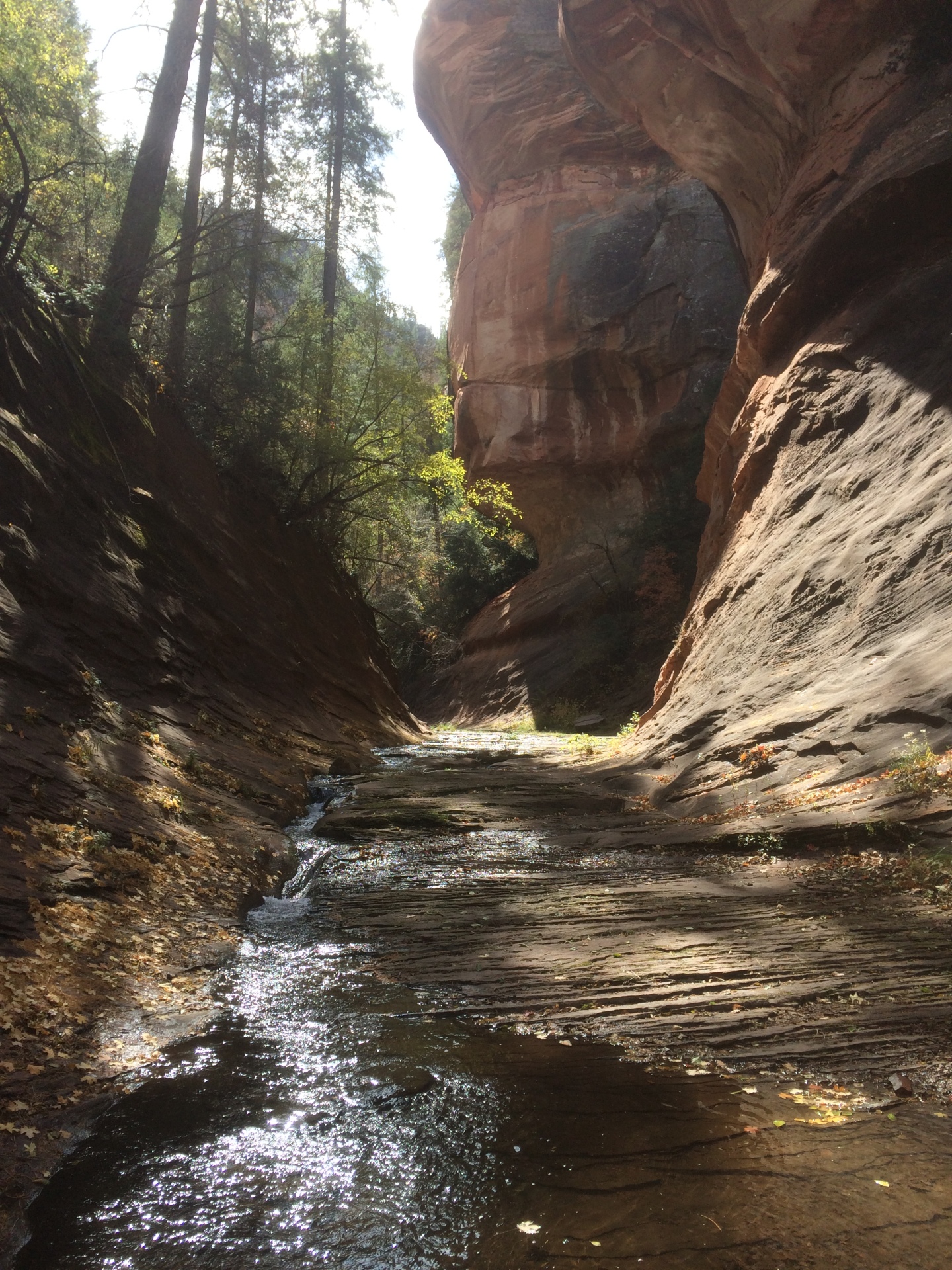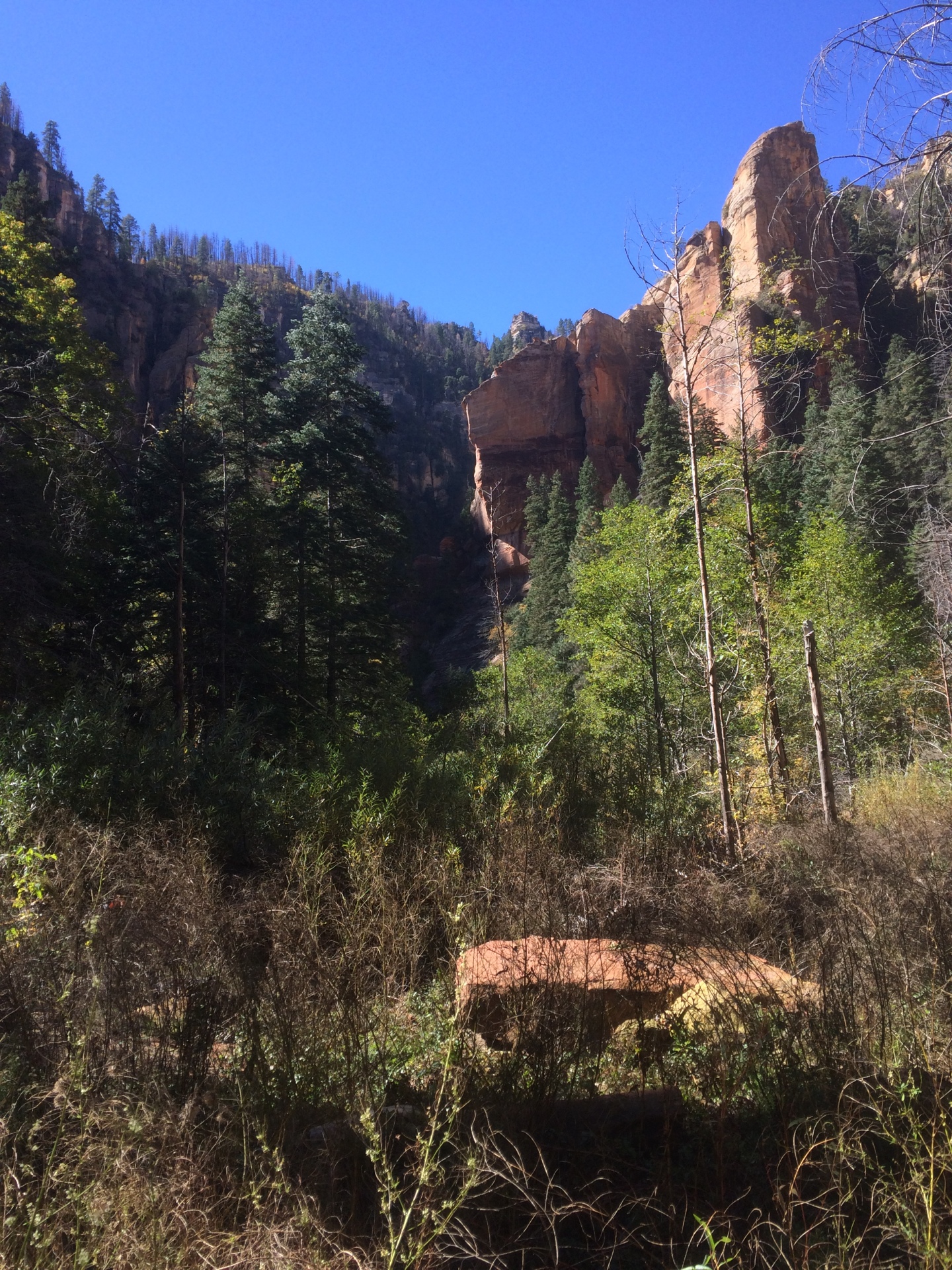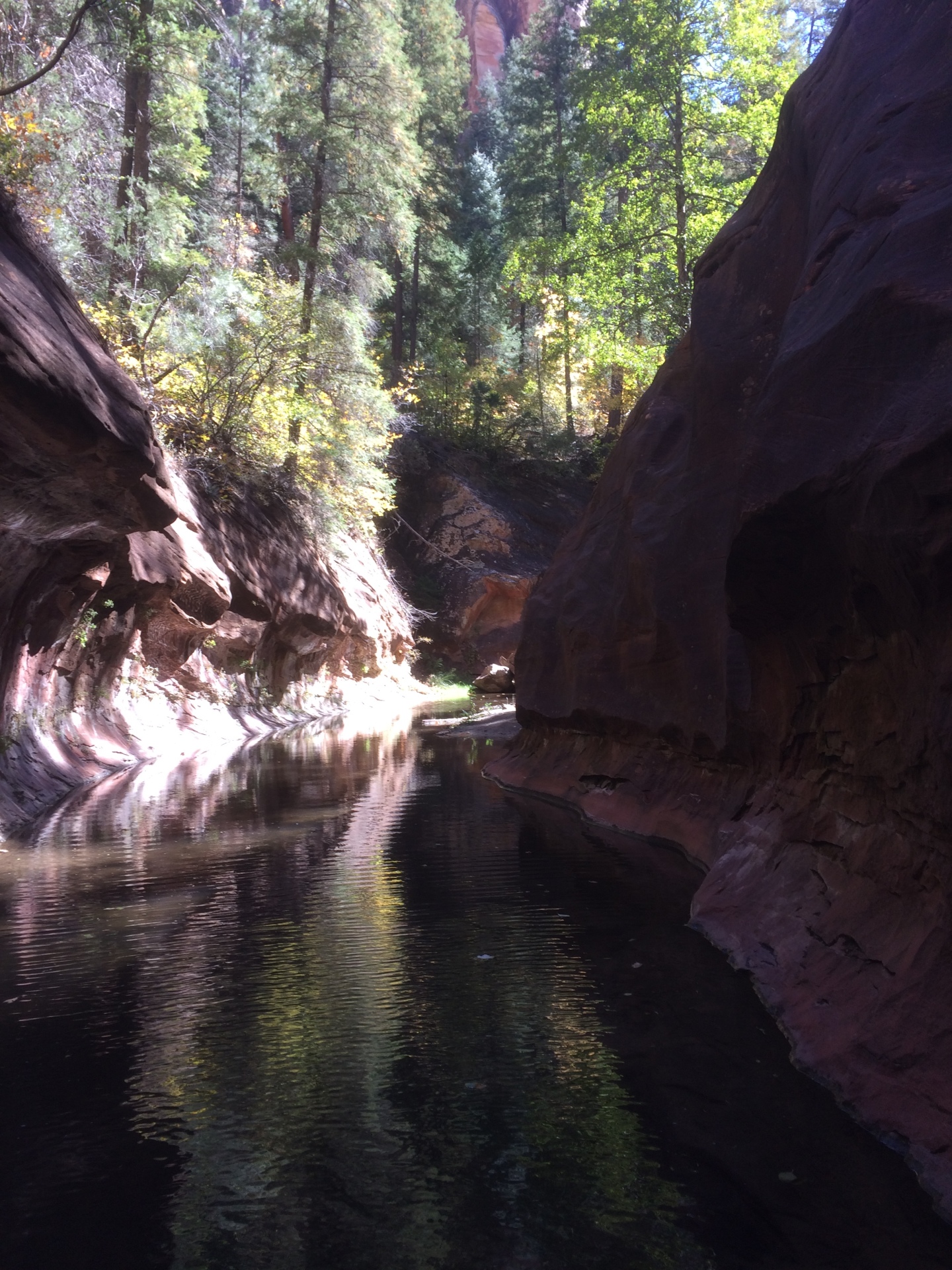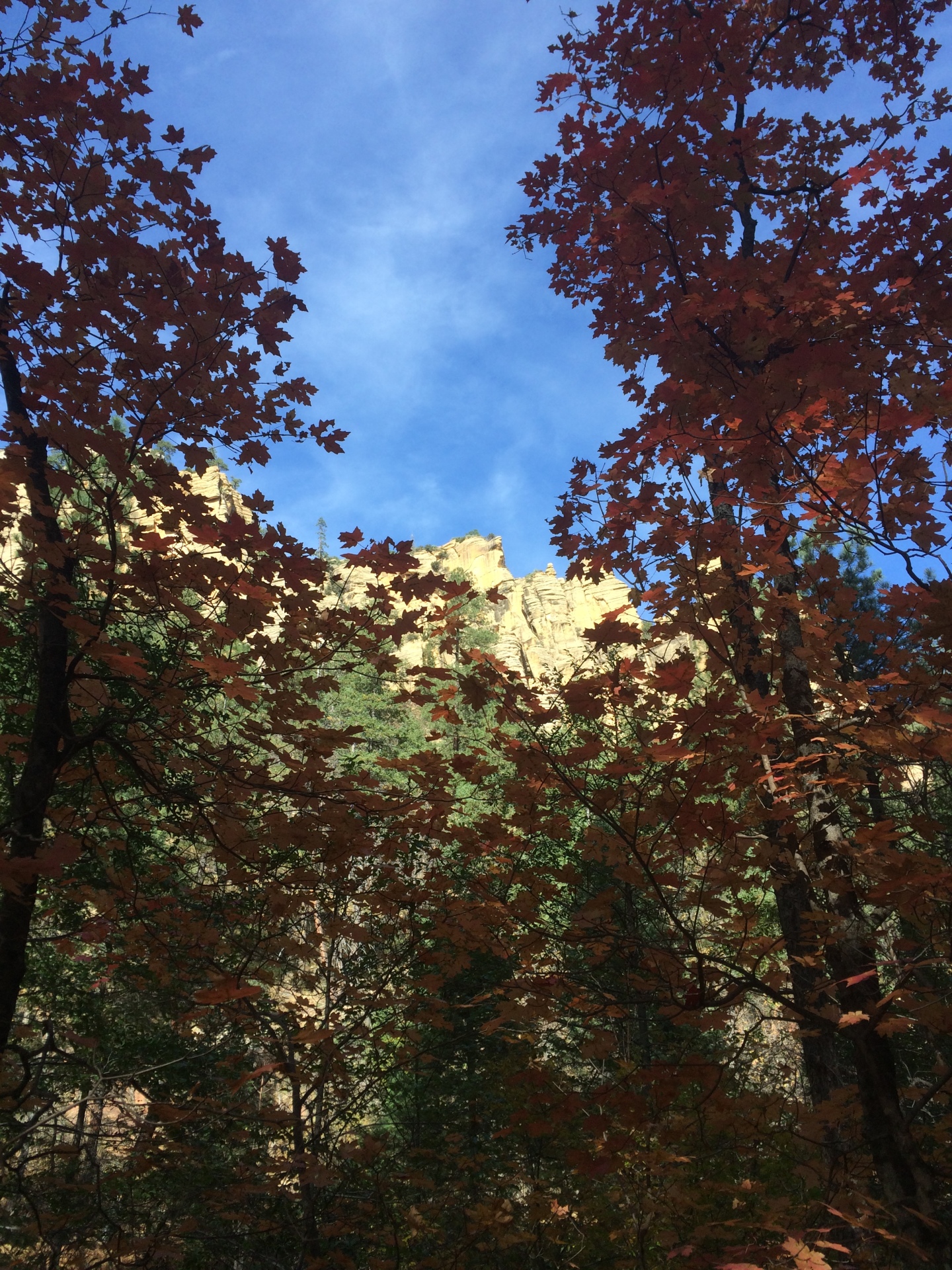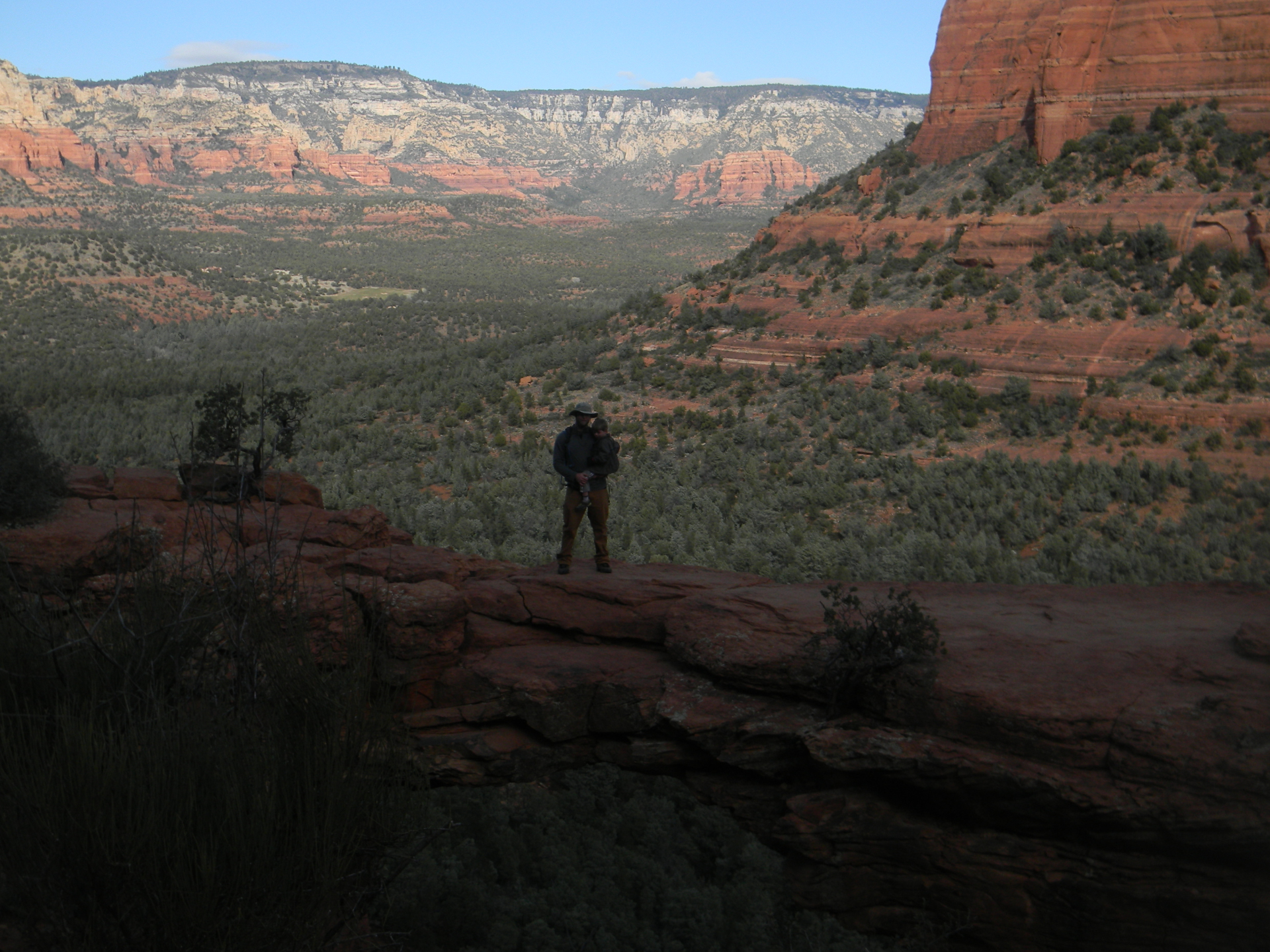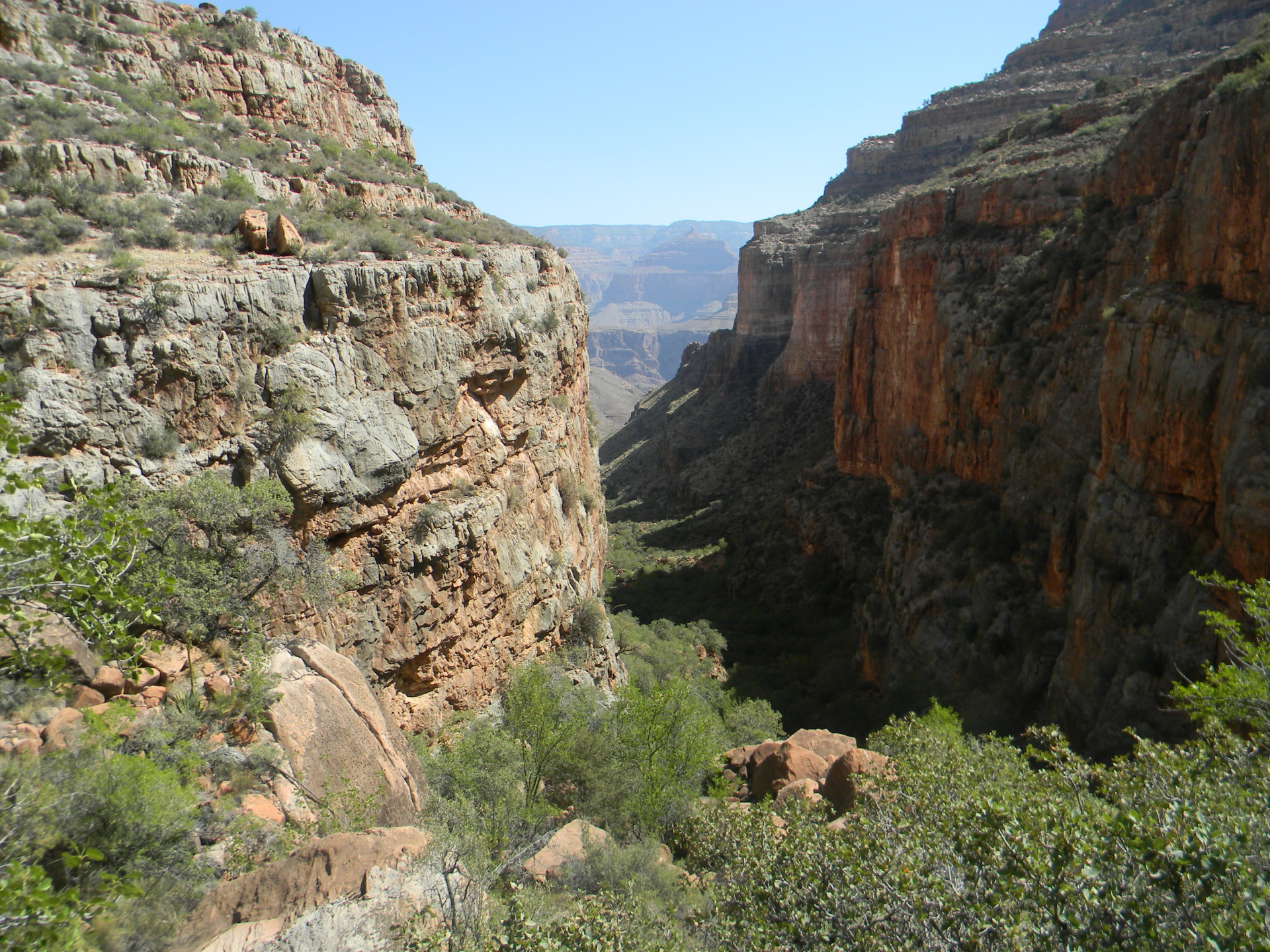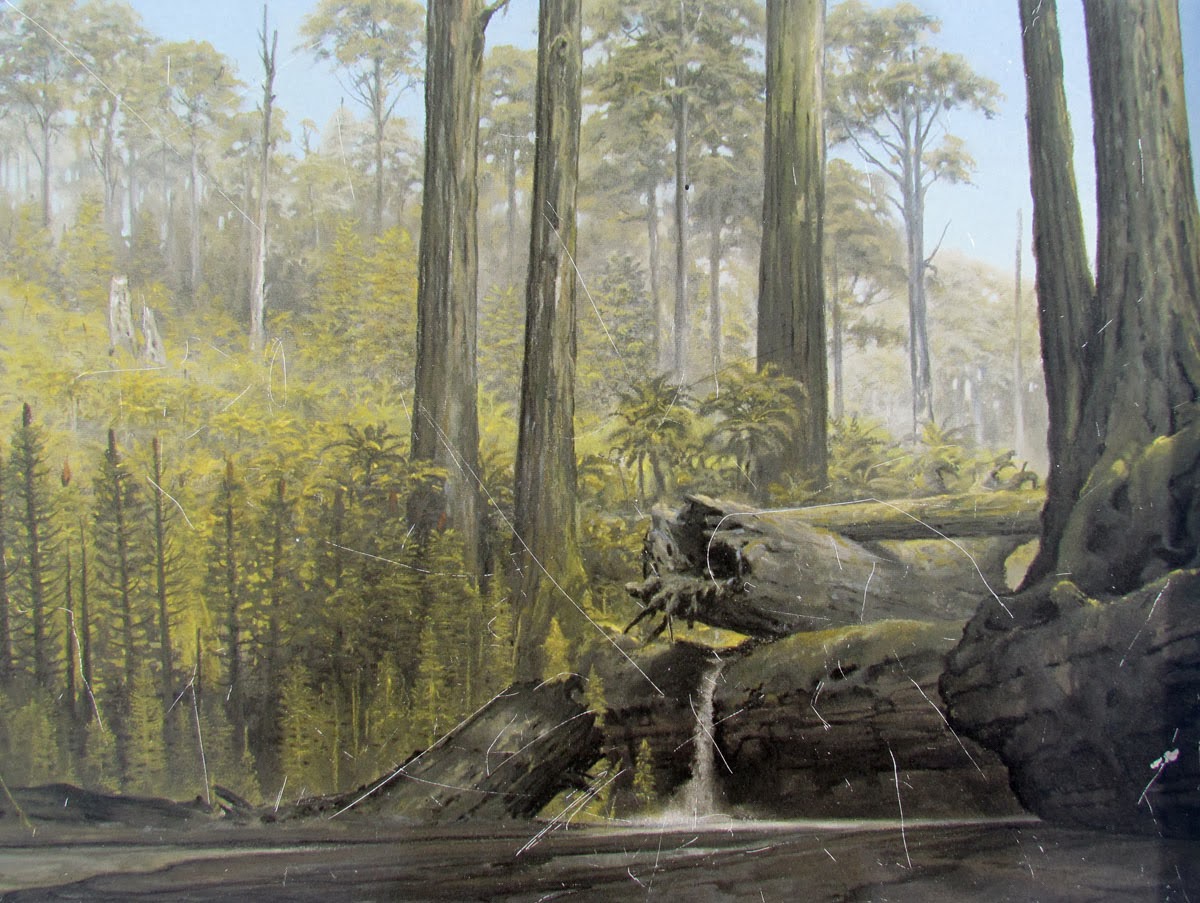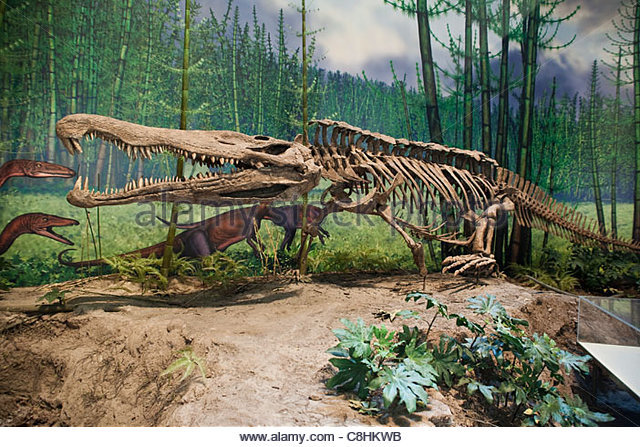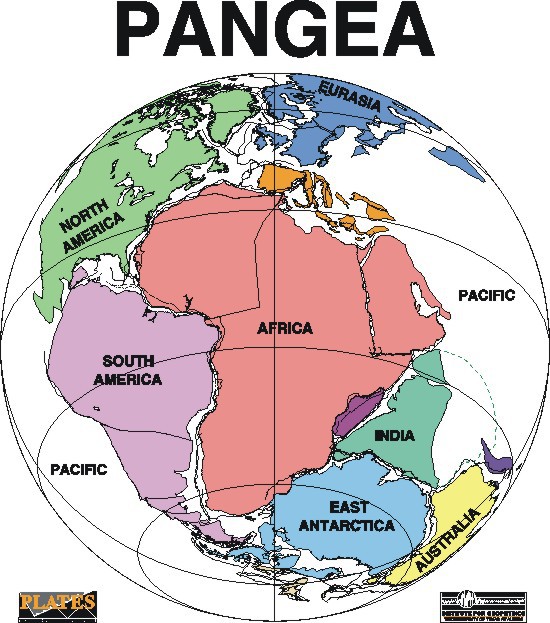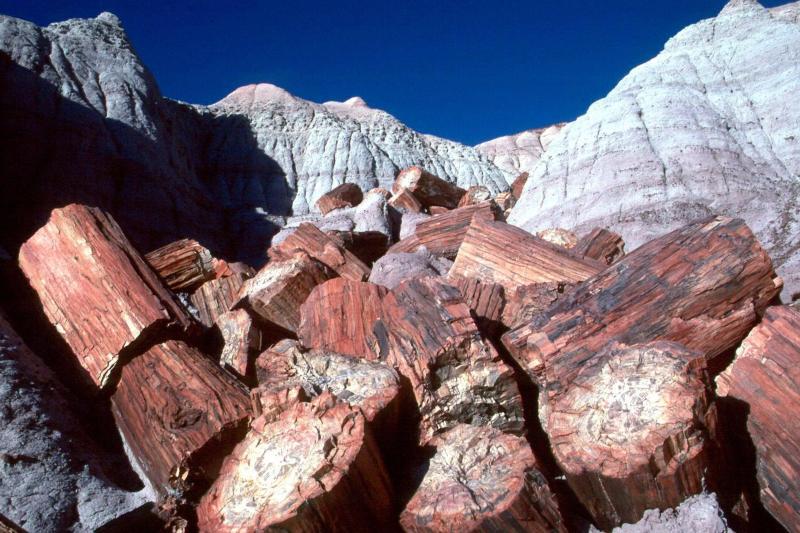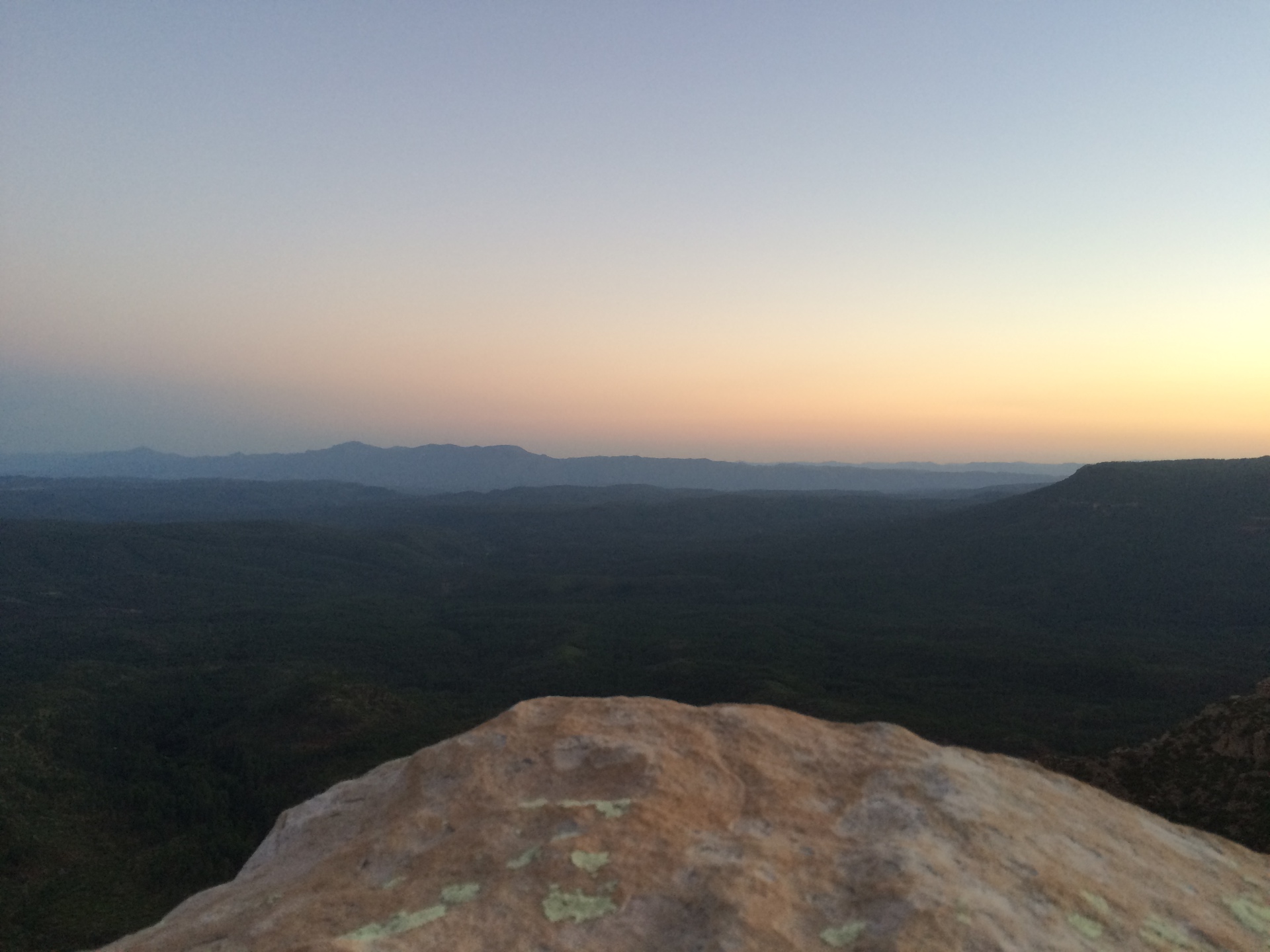
by The Goat | Aug 27, 2019 | Geology, Hiking, Sedona
What Makes Sedona so Special?
Every year, millions of tourists from all over the world flock to Sedona, AZ to see scenes published in magazines the globe over. They marvel at the fantastical red rocks, find zen in the spiritual vortex’s, and bask in the warm glow of one of the southwest’s premier geological wonders. But how did it get this way? The Goat knows.
West Fork Canyon, Oak Creek near Sedona, AZ
Our story begins nearly 320 million years ago in the Mississippian epoch of the Paleozoic era. Near the southwestern edge of the supercontinent known as Pangea, there is a white sand beach on a coastline with fertile rivers, tropical sunshine, and dense vegetation. Large, predatory fish scour out in the sea, while small reptiles and amphibians cruise the lush coast in search of food and shade.
The air is moist and warm here near the equator, and life is simple. Over the next 10 million years, the sea slowly regresses and the rivers flow out, carrying sediment eroded from the Ancestral Rocky Mountains across floodplains in a large, lazy meander. From Sedona to the Grand Canyon, the uppermost members of the Supai Group, known today as the Esplanade Sandstone, the Hermit Shale, and the Schebly Hill Formation are deposited in this proximal-marine, balmy, beachy, environment. This oxidized sediment gives the foundation for the blazing reds, oranges, and greens of modern-day Sedona as they are buried and turned to stone.
One of our clients strolling through blazing Sedona fall colors
As the seas recede and the rivers dry out with a drying climate, a massive sea of sand dunes migrates over the continent in a parched, desolate, desert landscape. Small reptiles scuttle across the dunes, drinking the water trapped under them in monsoonal rain events. This arid, windy dune sea, reminiscent of the modern-day Sahara, covers an area from south of Sedona to modern-day Montana, covering nearly 1/3 of the North American continent roughly 290 million years ago in the upper Permian epoch. These blonde dunes lay the foundation for the towering cliffs seen north of Sedona in Oak Creek Canyon, known today as the Coconino Sandstone.
Towering spires and cliffs in the Coconino Sandstone
Near the end of the Permian, nearly 273 million years ago, a warm shallow sea overtakes the sand dunes. This sea is teeming with life in an extensive coral reef system that is home to brachiopods, ammonites, bryozoans, sponges, and other non-vertebrate marine life, as well as small vertebrate fish. As these animals die, their carbonate shells mix with sediment to form a calcium-carbonate rock, known as limestone.
This limestone will be known as the Kaibab Limestone, and it forms the rims of both Oak Creek Canyon and the Grand Canyon further to the north in Arizona. This hard, erosion-resistant limestone protects the softer, more fragile formations under it, which will be very important over the next 270 million years.
Sparkling Pools in a hidden Canyon, Sedona, AZ
The Kaibab Limestone is the final sedimentary layer deposited in the Sedona region near the southwestern edge of Pangea, but it is far from the final geologic process that formed this wondrous place. The end of the Permian transforms life on Earth, as a mass extinction inflicts a 95% mortality rate of all species on Earth.
In the early Triassic of the Mesozoic, the age of the large reptiles, massive jungle swamps covered the land, forming the Chinle group and the Painted Desert. Still more cycles of rivers and floodplains ensued through the Jurassic into the Cretaceous as volcanoes formed and erupted, and Pangea broke apart, giving rise to the current continental map.
Sun-bathed Coconino Sandstone cliffs near Oak Creek
The Rocky Mountains were built in the north by the Laramide Orogeny, a process responsible for not only the mountains themselves, but some of the wonderful faults and structures such as anticlines and synclines that can be found in Sedona and around the region. During this process, something very important happened, as the plate sliding under the North American plate, known as the Farallon plate, suddenly snapped off about 25 million years ago, a portion of it remaining just below the crust in the mantle.
How was the Colorado Plateau formed?
This caused an entire region to be uplifted as the bouyant piece of plate quite literally “floated” in the mantle. This region, known now as the Colorado Plateau, was bounded by volcanic mountains as magma near the margins of the Farallon plate began to issue through weaknesses in the crust caused by the floating plate.
The Goat stands on famous Devil’s Arch in the Red Rock-Secret Mountain Wilderness of Sedona
Sedona itself lay at the very southwestern edge of this action, very near to several volcanoes and an ancient mountain range known as the Mogollon Highlands to its south. It was then that the North American plate began to “slide” back out over the Farallon and Pacific plates. This action formed the Basin and Range that encompasses Phoenix, Tucson, Las Vegas, and Death Valley today as areas of massive faulting, volcanism, and large, sediment-collecting basins.
Sedona was quite literally caught in the middle of this action. As the Mogollon Highlands “slid” to the south and the rivers that once flowed north from them ceased, new rivers began to cut south into the receding lowlands as the crust rifted. Faults, such as the Oak Creek and Verde faults, became active, cutting canyons (Oak Creek, Walnut Canyon, Sycamore Canyon) to the north and accommodating more river flow into the newly-formed valleys and basins left open by the receding Highlands.
Volcanoes continued to erupt to the north and south, issuing lava flows and ash that now dot the landscape. The basalt that caps Oak Creek Canyon is just under 8 million years old, and preserved the soft sediments beneath it as the newly created Oak Creek and its mother fault cut the canyon.
A hidden canyon near Sedona
These rivers chiseled out courses in the buttery sediment, leaving behind the fantasy-lands we see today. Many of these rivers still course their way down the valleys today, their work never done. Iconic and wondrous formations such as Cathedral Rock, The Coffee Pot, Wilson Moutain, and Vultee Arch are all remnants of these combined processes of sediment deposition, burial, mountain-building, volcanic eruptions, and water-based erosion. Come with us as we explore them all!
Going Guided
Hiking and exploring Sedona is a special experience. Although it is possible to see these places yourself, hiring a guide is a great idea. For instance, guiding services provide logistical support, and plan everything for your best possible trip. They provide a great safety net on the trail, and are trained in backcountry medicine. Above all, they provide a depth of knowledge of the region that turns a walk into a true adventure.
Blue Marble Adventure GeoTourism provides all of the support you need, and pairs that with expert geologist/guides. Our backcountry meals use fresh ingredients, and are planned by a professional chef. Furthermore, we provide top-of-the-line gear and passion for the places we explore. In conclusion, you can visit National Parks, but going with a guide can create and even more memorable experience. Don’t be shy, and call us!
Read our blog!
For adventure hiking vacations in a geologic time machine, see our epic tours in Grand Canyon, Utah, and Arizona!
For geological musings read The Goat’s geology blog.
Follow us on Facebookand Instagram
Explore Further, Be Wild, See Through Time — Blue Marble Adventure GeoTourism
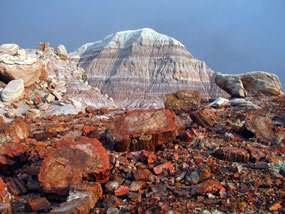
by The Goat | Aug 27, 2019 | History
Dinosaurs, Soaring Forests, and Giant Rivers
The Painted Desert is a beautiful and mysterious place. Perhaps its crown jewel is the Petrified Forest National Park, where one may encounter the largest known concentration of petrified wood on the planet, a pretty special distinction. From small shards to large trunks that are several feet in diameter, this natural phenomena dominates the stark, hauntingly beautiful landscape in northeastern Arizona.
The most fun part about being a geologist, or learning about geology, is the creativity and imagination in picturing how a landscape like the Petrified Forest came to be. Why is it here? The story told by the rocks and fossils in this wondrous place is one that winds through the sands of time, beginning nearly 225 million years ago in an era known as the Triassic……
The clock keeps on ticking…
As the years fly by, transporting us to this very place, we find ourselves standing in a towering deciduous forest. These trees, some perhaps 100m tall, dominate the skyline and provide a lush canopy of greenery for the local flora and fauna. We are close to the equator, inland on the supercontinent known as Pangea, formed when all the continents were sutured together by plate tectonics.
Artist’s rendering of a Late Triassic scence (courtesy geolhistory.com)
A giant dragonfly, one roughly the size of an adult males’ hand, swoops by, landing nearby on a fern in the swampy landscape. The vegetation is dense, the air is humid, and the smell in the air is a pungent mix of decaying organic matter and still water. We are in a sub-tropical jungle, similar to one you might find in modern day Central America, and it is quite hot. As we stomp though the brush swinging our machetes, we come to a clearing where a wide, shallow, lazy river is coursing its way through the forest, bound on each side by floodplains.
Wild Dinosaurs
Following the river we find tracks. What are they? Large Phytosaurs are fishing and sunning themselves on the bank of this warm river, while the other titan of the Triassic, Rauisuchian, steers clear. Many other smaller dinosaur-like reptiles and crocodilian vertebrates roam around the brushy banks and Pterosaurs circle in the air, looking for fish and small mammals.
The Phytosaur, top predator of the Triassic
The scene is serene, peaceful. A warm, wet wind blows through the river valley, rustling fern leaves and wafting tree seeds. Though you may not want to go, time steps forward. Over the next 150 million years, this scene is buried by larger rivers, deserts, and lakes. Trees fall and muds and sands carried by the ever-coursing rivers of change bury the trees and dinosaurs, entombing them to one day rise again. Pangea rifts apart near the end of the Cretaceous and massive volcanic outputs combine with extra-terrestrial impacts to wipe the planet clean, giving rise the mammals that heretofore existed only underground.
The Supercontinent Pangea. The PFNP was located near the southwestern edge of the North American continent
The Mountains….
Then, as the Rocky Mountains are built to the northeast, the land is thrust upward, exposing it to the surficial winds and waters that carve the most epic of landscapes. The Petrified Forest member of the widespread Chinle Formation, the colorful and unique formation that creates the brush stroke appearance of the Painted Desert, peeks its head out from its long slumber under the layers of sediment that buried it long ago. The trees have undergone a fossilization process known as silicification, wherein silica (SiO2) replaces organic material over long periods of time, while the rest of the landscape has undergone a process called diagenisis, or the combination of processes that renders sediment into rock.
The modern-day Petrified Forest near Blue Mesa
As modern life took hold over the thousands of years of human evolution and exploration, this area was noted as special and unique, and preserved for the generations when it was designated as a National Monument in 1906, then as a National Park in 1962. Today it stands as one of the most fascinating and unique places on the face of the Earth.
Going Guided
Hiking and exploring any of the National Parks, is a special experience. Although it is possible to see these places yourself, hiring a guide is a great idea. For instance, guiding services provide logistical support, and plan everything for your best possible trip. They provide a great safety net on the trail, and are trained in backcountry medicine. Above all, they provide a depth of knowledge of the region that turns a walk into a true adventure.
Blue Marble Adventure GeoTourism provides all of the support you need, and pairs that with expert geologist/guides. Our backcountry meals use fresh ingredients, and are planned by a professional chef. Furthermore, we provide top-of-the-line gear and passion for the places we explore. In conclusion, you can visit National Parks, but going with a guide can create and even more memorable experience. Don’t be shy, and call us!
Read our blog!
For adventure hiking vacations in a geologic time machine, see our epic tours in Grand Canyon, Utah, and Arizona!
For geological musings read The Goat’s geology blog.
Follow us on Facebookand Instagram
Explore Further, Be Wild, See Through Time — Blue Marble Adventure GeoTourism
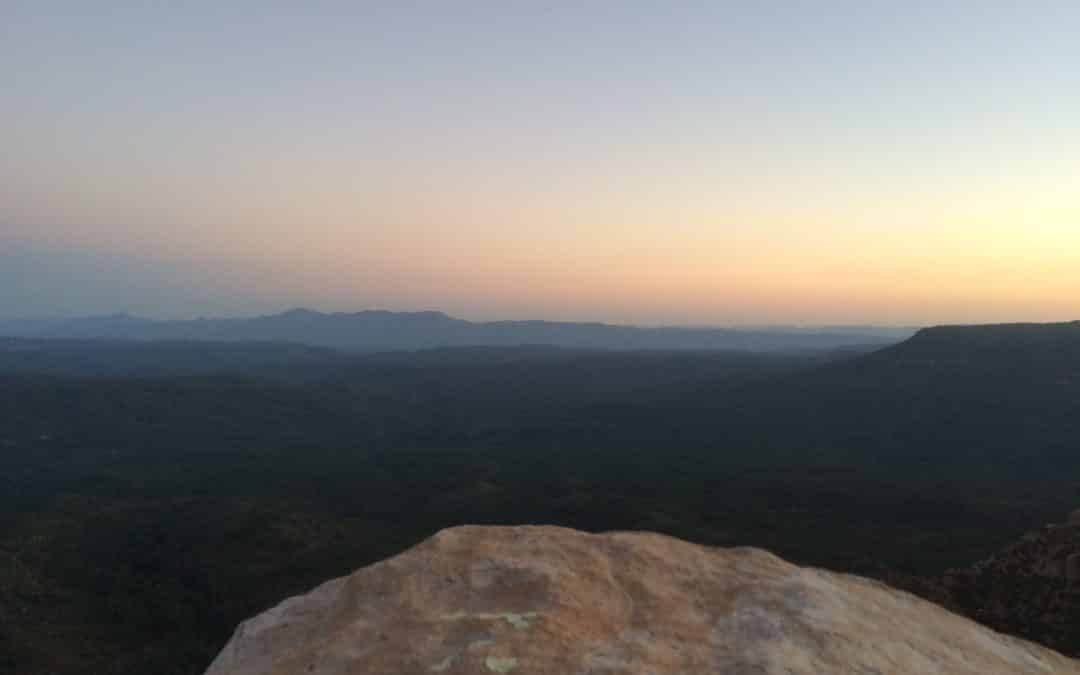
by The Goat | Aug 27, 2019 | Backpacking, Hiking
Hiking on the Mogollon Rim, Arizona
With so many jaw-dropping natural features, Arizona can be almost overwhelming in terms of choices. Let us simplify things for you: go to the Mogollon Rim. Why? Lakes, canyons, spectacular scenery, wildlife, solitude, cool summer weather, history, and of course, geology.
Geology
“The Rim” is the actual edge of the Colorado Plateau, famous for the Grand Canyon, Zion, Bryce, Arches, Canyonlands, volcanoes, rivers, and some of the most outrageous displays of sedimentary geology in the world. To the south lies the Transition Zone and the Basin and Range, geologic provinces characterized by extensional faulting and the Sonoran/Mojave Deserts. It is the last bastion of the flat-lying sediments, the precipitous drop-off to the ends of the Earth.
History
Sitting over 1000ft. higher than the land just to the south, The Rim provides a dramatic gateway to Plateau country, and has indeed been the sentinel of our beloved Plateau. As civilization expanded with the railroad and the Westward Migration of the late 19th century, the Mogollon Rim kept large swaths of civilization away with its foreboding cliffs and complex topography. In 1871, General George Crook was given the task of creating a throughway across The Rim from Fort Apache near present day Show Low, AZ to Fort Verde near present-day Prescott, AZ. Today, this road serves as The Rim Road, and is the main route of travel on The Rim, providing access to all the lakes and scenic points that it offers.
Hiking
The Mogollon Rim offers nearly limitless hiking opportunities. Simply hiking along the rim itself is a great experience. Exploring the many canyons carved into the rim provides adventures for all levels, from easy strolls to technical descents. The Arizona Trail runs through the rim, and is a great trail to explore if this is your first time here.
Going Guided
Hiking and exploring the Mogollon Rim is a special experience. Although it is possible to see these places yourself, hiring a guide is a great idea. For instance, guiding services provide logistical support, and plan everything for your best possible trip. They provide a great safety net on the trail, and are trained in backcountry medicine. Above all, they provide a depth of knowledge of the region that turns a walk into a true adventure.
Blue Marble Adventure GeoTourism provides all of the support you need, and pairs that with expert geologist/guides. Our backcountry meals use fresh ingredients, and are planned by a professional chef. Furthermore, we provide top-of-the-line gear and passion for the places we explore. In conclusion, you can visit National Parks, but going with a guide can create and even more memorable experience. Don’t be shy, and call us!
Read our blog!
For adventure hiking vacations in a geologic time machine, see our epic tours in Grand Canyon, Utah, and Arizona!
For geological musings read The Goat’s geology blog.
Follow us on Facebookand Instagram
Explore Further, Be Wild, See Through Time — Blue Marble Adventure GeoTourism
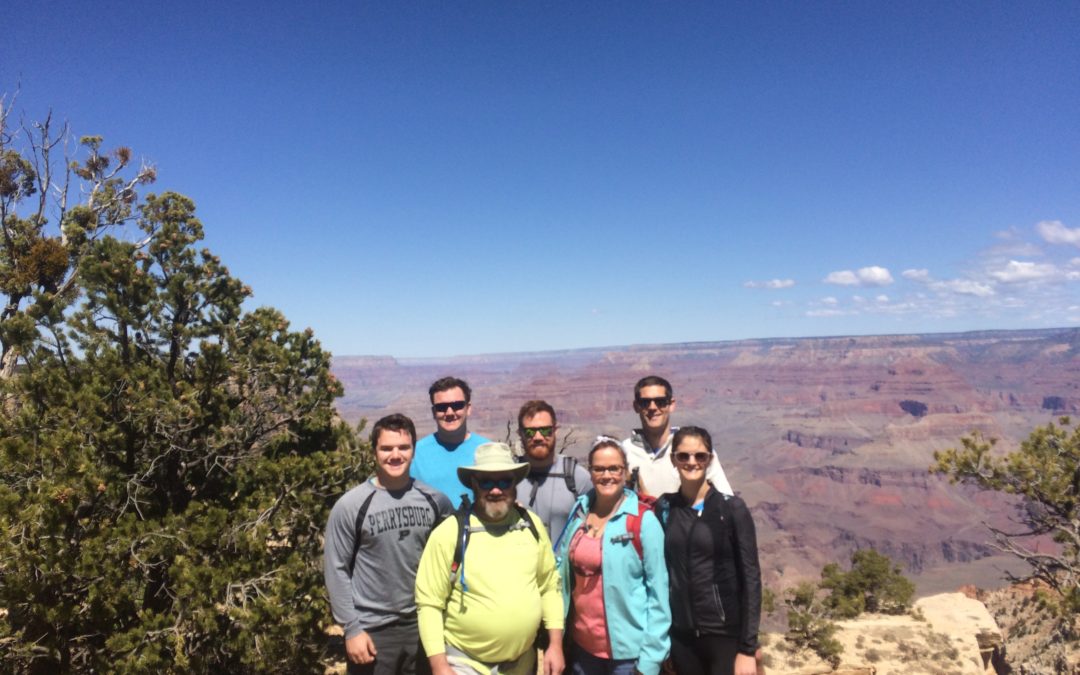
by The Goat | Aug 27, 2019 | Backpacking, Hiking
Surviving the Wilds’ Fury
Accidents happen. It is a fact of life, and a solid fact of outdoor adventure. We felt compelled to write this blog post in response to the latest tragedy in our backyard, as a young women perished in the Grand Canyon after falling at Ooh-Ahh Point on the South Kaibab Trail. Hiking with friends, she snapped a few photos, posted them to Instagram, then in a moment she was gone. As gut-wrenching as this story is, it paints an all-too-real picture of the perils faced daily by adventurers not just in the Grand Canyon, but all over the southwest and around the world. A moment’s carelessness or inattention can have serious and potentially fatal consequences, and it is important to remember that whether we like it or not, Mother Nature is a cruel and unforgiving mistress.
It’s not all doom and gloom, and of course nothing should discourage you from getting outdoors and maximizing your adventure. However, a few things to remember may save your life or your health the next time you are on the trail here in the desert southwest.
1. Plan Ahead
Knowing where you’re going and what it’s going to be like when you get there is key. Will there be a reliable water supply? What is the terrain like? What are the weather conditions going to yield? What kind of special gear do you need? Will there be quick help in the case of an emergency?
Having all the information may seem obvious, but it is amazing how many people we run into, especially in this part of the world, that are woefully unprepared for even a short hike in the desert. They don’t know where they’re going, they don’t have enough provisions or the right gear, they are wildly arrogant, or badly misinformed. Any of those shortcomings can result in peril, so know what you’re doing and have a plan.
2. Bring Water
This falls into preparation, but it is almost unbelievable the amount of people we see every year carrying nothing but one bottled water. It’s 90 degrees, no shade, no moving water, and you and your group of 7 want to make it 6 miles? People, bring more water than you think you need, and cache it along the trail.
3. Bring More Water
See above.
4. Bring even more water
— And drink it consistently, not gulping gallons after long periods of not drinking. If you feel thirsty, dehydration is already setting in.
5. Beware the edge
The edge of cliffs, the edge of trees with thorns, the edge of the trail, the edge of sharp rocks, the edge of potential wildlife (snake) burrows, and so on are all things you should be aware of. Don’t venture out on perilous outcrops, don’t stick your hand where you can’t see, and be on notice that everything in the desert will fight back (even the prettiest of flowers)
6. Protect yourself from the sun
Hats, sunscreen, sunglasses, and light-colored synthetic clothing are essential to avoiding sunburn, and even worse, heat stroke. Although a sunburn may be uncomfortable, heat stroke can be deadly, and out here in the desert it will creep up on you much quicker than you think.
7. Make Common Sense Decisions
Again, this may seem condescending, but common sense can save your life. Do you really need to snap that outrageous selfie? Does your dog really need to come with you into a slot canyon? Is finishing this hike more important than living? People that find themselves in a bind have almost always made a series of decisions that put marginal gains ahead of group safety.
8. Carry the right gear
Before you set out on any hike, you should have these things: Proper footwear, water, first aid, and navigation materials (map, compass, GPS).
9. Have Fun!
Walk at a reasonable pace, keep the group together, take breaks, drink plenty, eat plenty, stay in the shade, and enjoy the views. If you can do this, you will make it back to tell everyone of your grand adventures.
Of course, instead of taking this all into your own hands, you could let one of Blue Marble Adventure GeoTourism’s geologist/guides take care of all of this for you. We are Wilderness First Responder Certified, First Aid/CPR trained, and have years of wilderness experience. We will make sure that you have fun, and make it back in one piece! However, we just want to make sure that any adventure you take, with or without us, is memorable and safe for you and everyone that you are with. See you out there!
Going Guided
Hiking and exploring Grand Canyon, or any of the National Parks, is a special experience. Although it is possible to see these places yourself, hiring a guide is a great idea. For instance, guiding services provide logistical support, and plan everything for your best possible trip. They provide a great safety net on the trail, and are trained in backcountry medicine. Above all, they provide a depth of knowledge of the region that turns a walk into a true adventure.
Blue Marble Adventure GeoTourism provides all of the support you need, and pairs that with expert geologist/guides. Our backcountry meals use fresh ingredients, and are planned by a professional chef. Furthermore, we provide top-of-the-line gear and passion for the places we explore. In conclusion, you can visit National Parks, but going with a guide can create and even more memorable experience. Don’t be shy, and call us!
Read our blog!
For adventure hiking vacations in a geologic time machine, see our epic tours in Grand Canyon, Utah, and Arizona!
For geological musings read The Goat’s geology blog.
Follow us on Facebookand Instagram
Explore Further, Be Wild, See Through Time — Blue Marble Adventure GeoTourism
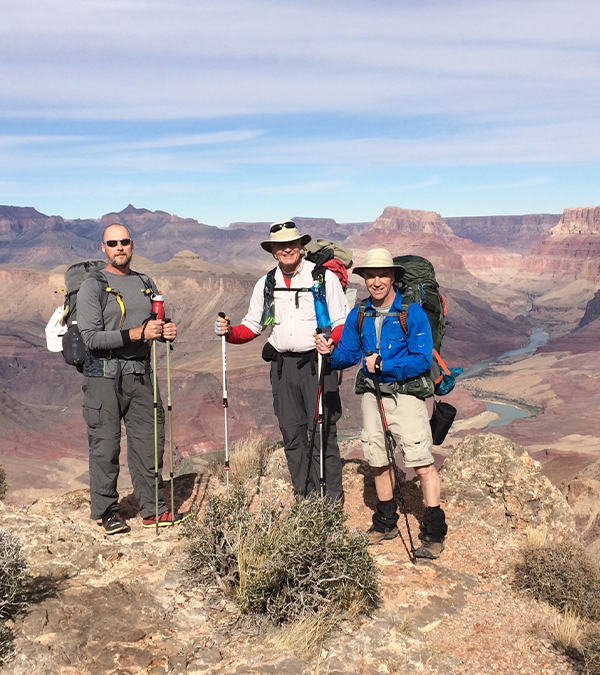
by The Goat | Aug 27, 2019 | Backpacking, Grand Canyon
Grand Canyon Backpacking Packing List
About to embark on the trip of a lifetime, Fred reaches into his bag. He expects to find his sunglasses; and he needs them quite badly in fact. Fred is about to begin a hike in the Grand Canyon, just a couple of days in paradise. However, he got so caught up dreaming about how much fun he was going to have that he remembered to pack three sweaters and some long underwear, but forgot his sunglasses. Fred now has a problem: His pack is too heavy with items that he doesn’t need (it’s July), and he lacks an item that will save him from three days of squinting and headaches. Fred should have read this blog.
We have all been Fred at some point in our lives; not focused on the task at hand and blanking on something that we really needed. Here, we will outline must-have items for hiking and adventuring in all of the wonderful places that you will go with Blue Marble Adventure GeoTourism (in all seasons). We will assume a three-day hiking/backpacking trip in Grand Canyon National Park. Although we will send you a packing list for any of the trips you go on, this is a good reference point for any adventure you may have. See you out there!
Clothing:
2 short-sleeve synthetic (not cotton) shirts
1 pair shorts
1 pair light pants
1 rain jacket
3 pairs underwear
3 pairs socks
1 brimmed hat
1 pair sunglasses
Gear:
Large backpack
1-person tent w/ footprint
35-degree sleeping bag
Sleeping pad
3L Water bladder, full
1 32oz. water bottle, full
Map
Compass
Headlamp
Fire starting materials (lighter, flint)
Knife or Multi-tool
Toothbrush
Toothpaste
First-Aid kit (disinfectant, bandages, tweezers, etc.)
Sunscreen
Insect repellent
Cell Phone
Water purification gear (tablets or apparatus)
Cooking gear (pots, spoons, backpacking stove, propane)
Food:
Meals for every day you will be on the trail (breakfast, lunch, dinner, snacks). Dehydrated meals are best, or check out our backpacking recipe blog
Luxury Items (At your discretion):
Books
Travel board games
Balls, recreational items
Ipod
Binoculars
This is not necessarily a complete list, but should give you some idea of how to go about packing for adventures in the outdoors.
Going Guided
Hiking and exploring Grand Canyon, or any of the National Parks, is a special experience. Although it is possible to see these places yourself, hiring a guide is a great idea. For instance, guiding services provide logistical support, and plan everything for your best possible trip. They provide a great safety net on the trail, and are trained in backcountry medicine. Above all, they provide a depth of knowledge of the region that turns a walk into a true adventure.
Blue Marble Adventure GeoTourism provides all of the support you need, and pairs that with expert geologist/guides. Our backcountry meals use fresh ingredients, and are planned by a professional chef. Furthermore, we provide top-of-the-line gear and passion for the places we explore. In conclusion, you can visit National Parks, but going with a guide can create and even more memorable experience. Don’t be shy, and call us!
Read our blog!
For adventure hiking vacations in a geologic time machine, see our epic tours in Grand Canyon, Utah, and Arizona!
For geological musings read The Goat’s geology blog.
Follow us on Facebookand Instagram
Explore Further, Be Wild, See Through Time — Blue Marble Adventure GeoTourism


